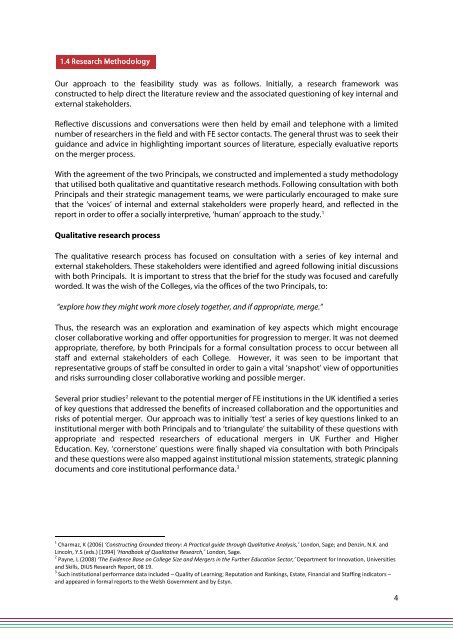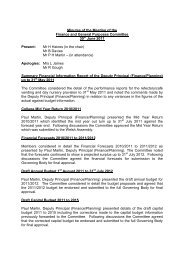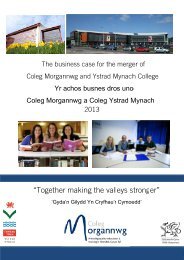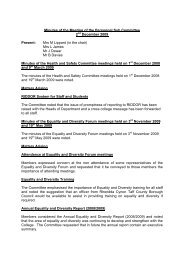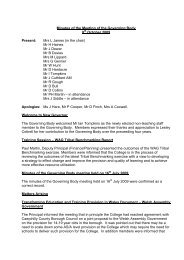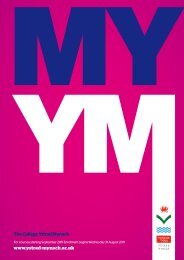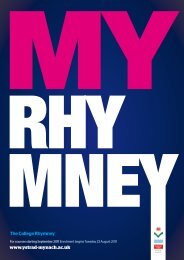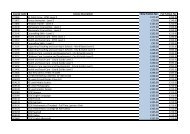FEASIBILITY STUDY
FEASIBILITY STUDY: - Ystrad Mynach College
FEASIBILITY STUDY: - Ystrad Mynach College
- No tags were found...
Create successful ePaper yourself
Turn your PDF publications into a flip-book with our unique Google optimized e-Paper software.
Our approach to the feasibility study was as follows. Initially, a research framework was<br />
constructed to help direct the literature review and the associated questioning of key internal and<br />
external stakeholders.<br />
Reflective discussions and conversations were then held by email and telephone with a limited<br />
number of researchers in the field and with FE sector contacts. The general thrust was to seek their<br />
guidance and advice in highlighting important sources of literature, especially evaluative reports<br />
on the merger process.<br />
With the agreement of the two Principals, we constructed and implemented a study methodology<br />
that utilised both qualitative and quantitative research methods. Following consultation with both<br />
Principals and their strategic management teams, we were particularly encouraged to make sure<br />
that the ‘voices’ of internal and external stakeholders were properly heard, and reflected in the<br />
report in order to offer a socially interpretive, ‘human’ approach to the study. 1<br />
Qualitative research process<br />
The qualitative research process has focused on consultation with a series of key internal and<br />
external stakeholders. These stakeholders were identified and agreed following initial discussions<br />
with both Principals. It is important to stress that the brief for the study was focused and carefully<br />
worded. It was the wish of the Colleges, via the offices of the two Principals, to:<br />
“explore how they might work more closely together, and if appropriate, merge.”<br />
Thus, the research was an exploration and examination of key aspects which might encourage<br />
closer collaborative working and offer opportunities for progression to merger. It was not deemed<br />
appropriate, therefore, by both Principals for a formal consultation process to occur between all<br />
staff and external stakeholders of each College. However, it was seen to be important that<br />
representative groups of staff be consulted in order to gain a vital ‘snapshot’ view of opportunities<br />
and risks surrounding closer collaborative working and possible merger.<br />
Several prior studies 2 relevant to the potential merger of FE institutions in the UK identified a series<br />
of key questions that addressed the benefits of increased collaboration and the opportunities and<br />
risks of potential merger. Our approach was to initially ‘test’ a series of key questions linked to an<br />
institutional merger with both Principals and to ‘triangulate’ the suitability of these questions with<br />
appropriate and respected researchers of educational mergers in UK Further and Higher<br />
Education. Key, ‘cornerstone’ questions were finally shaped via consultation with both Principals<br />
and these questions were also mapped against institutional mission statements, strategic planning<br />
documents and core institutional performance data. 3<br />
1 Charmaz, K (2006) ‘Constructing Grounded theory: A Practical guide through Qualitative Analysis,’ London, Sage; and Denzin, N.K. and<br />
Lincoln, Y.S (eds.) [1994] ‘Handbook of Qualitative Research,’ London, Sage.<br />
2 Payne, L (2008) ‘The Evidence Base on College Size and Mergers in the Further Education Sector,’ Department for Innovation, Universities<br />
and Skills, DIUS Research Report, 08 19.<br />
3 Such institutional performance data included – Quality of Learning; Reputation and Rankings, Estate, Financial and Staffing indicators –<br />
and appeared in formal reports to the Welsh Government and by Estyn.<br />
4


